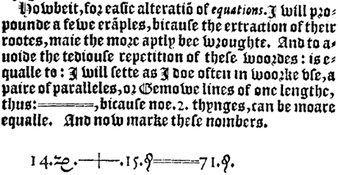
urbansheep@gmail.com
Notation, notation, notation: a brief history of mathematical symbols | Joseph Mazur | Science | theguardian.com - http://www.theguardian.com/science...

|
25 мая 2014 в 20:14 с Bookmarklet
Prometa
alf
пойду-ка я поработаю
Dana Del Rey
адская скорлупа
Peter Fedin
псы в рапиде
9000
ftt
vampire vegetable
скажу, хоть тред не читал
кот от котов
“Even our wonderful symbol for equality – you know, those two parallel lines – was not used in print before 1575, when the Welsh mathematician and physician Robert Recorde wrote an algebra book that he called the Whetstone of Witte. (We can only guess that the title is a pun on sharpening mathematical wit.) In it he wrote “is equal to” almost two hundred times for the first two hundred pages before finally declaring that he could easily “avoid the tedious repetition” of those three words by designing the symbol “=====” to represent them. ¶
In that book we find + and – printed in English for the first time.” • #типографика - × × ×
Нормально, «первые двести раз писал словами «что равно», а потом задолбался и — — —». - × × ×
А, и я не сразу обратил внимание, на КДПВ шикарный язык же, набранный готикой. И двоеточия в качестве чего-то среднего между тире и кавычками! Ух. “bicause noe.2.thynges, can be moare equalle”. Алгебра на уэлльском! - × × ×
© 2015 FriendFeed (and Clio archiver)